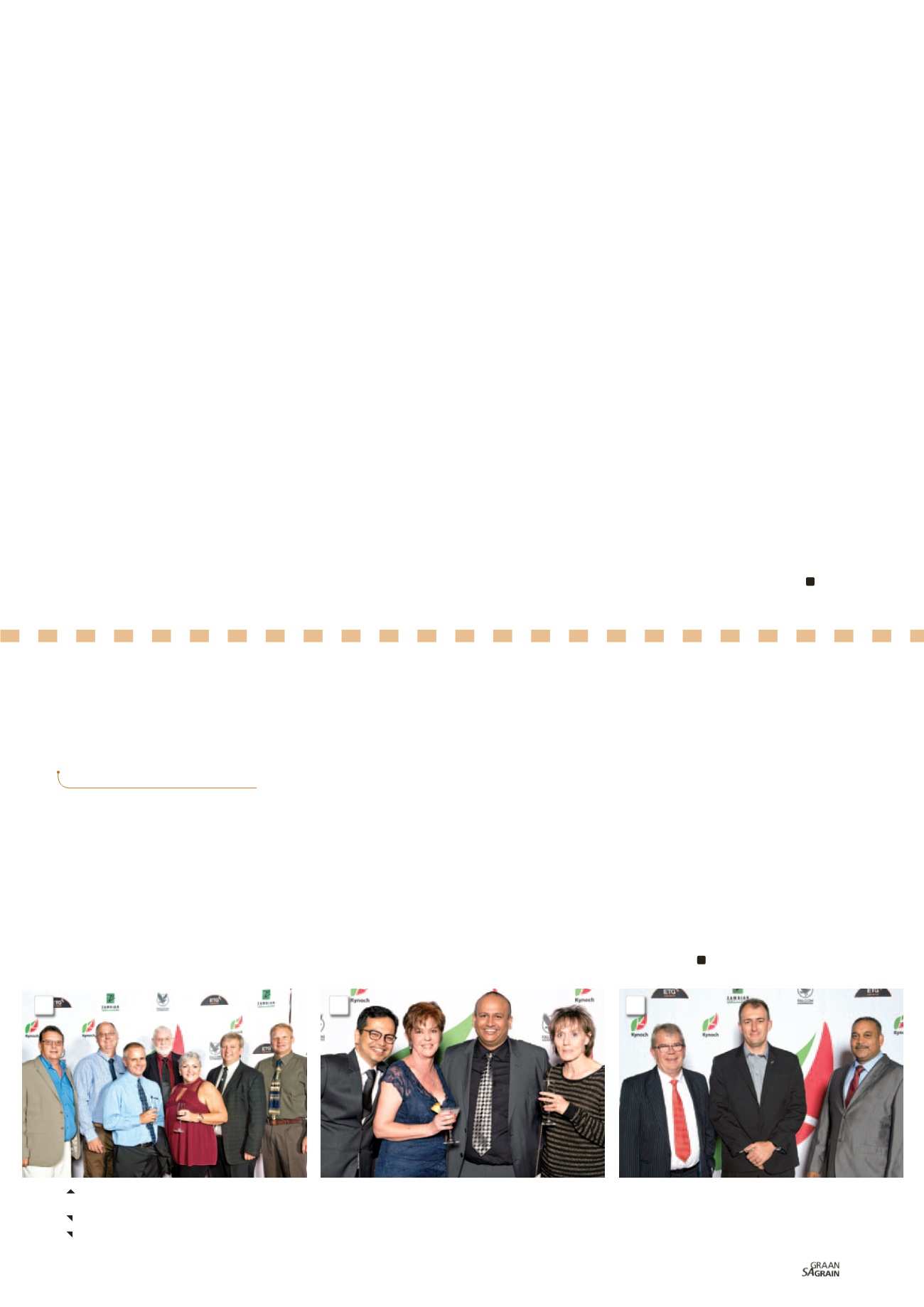

Swierige eeufeesvieringe
K
ynoch het op 23 Maart vanjaar hul 100ste bestaansjaar in
Suid-Afrika met ‘n swierige aandfunksie gevier. ’n Kort
video waarin Kynoch se ryk erfenis en toekomsvisie met
die gaste gedeel is, was een van die hoogtepunte van die
aand se verrigtinge.
Mnr Niren Murugan (streekshoof: Suid-Afrika) het gesê: “Ons almal
by Kynoch en ETG voel trots en dankbaar om hierdie eeufeesvie
ringe van Kynoch as ’n kunsmisvervaardiger en -verskaffer te vier.
Kynoch is een van die bekendste en gerespekteerde handelsmerke
in die Suid-Afrikaanse landbousektor. Ons vier ons ryk erfenis en
sien met groot verwagting uit na die volgende 100 jaar. Kynoch
sal voortgaan om innoverende produkte en dienste aan ons land-
boukliënte te lewer.”
Het jy geweet?
Die Kynoch handelsmerk is vernoem na sy stigter, George Kynoch.
Die oorspronklike maatskappy, vandag bekend as Kynoch Kunsmis,
het sy ontstaan in Birmingham, Engeland gehad en was aanvanklik
’n ammunisie- en plofstofvervaardiger.
SA GRAAN/GRAIN
REDAKSIE
97
July 2018
funding bodies and breeding programmes. Primary funding bodies
include Grain SA, The Department of Science and Technology and
the Winter Cereal Trust, and the recipient stakeholder breeding
programmes include the ARC-Small Grain (public), Sensako and
Pannar (both private).
The second and third objectives are closely intertwined and in-
volve germplasm development and screening followed by directed
crossing. Crossing in the pre-breeding programme is based on
the plant breeding laboratory’s male sterility (facilitated by a domi-
nant sterility gene Ms3) mediated marker assisted recurrent selec-
tion scheme.
The fourth objective explores the use of molecular markers, and the
plant breeding laboratory in conjunction with the ARC-Small Grain
is busy with the identification, optimisation and implementation of
yield related trait markers. This part of the larger project is also an
International Wheat Yield Partnership – an international alliance
aimed at yield improvement through international collaboration
– aligned project.
High throughput phenotyping is the fifth objective and involves
the use of drones (Y-framed, quad copters and a fixed wing) to fa-
cilitate digital imaging of breeding material. The drone platform can
already be used to generate 2D and 3D data for field trials, which
include plot based RGB and NDVI maps. The project is also in the
process of deploying thermal camera technology this coming
growth season that will assist in measuring canopy temperatures.
The most important objective from a stakeholder point of view is,
however, the distribution of germplasm. As such, germplasm is an-
nually distributed to stakeholders packaged as nurseries. During
2018, the 13th annual nursery was distributed and consisted out of
270 lines that could either be hand-sown (one package of seed con-
sisting 15 g) or planted as yield plots (four packages of 100 g).
According to a 2016 survey among the recipient breeding pro-
grammes on average 44 selections per season are made and includ-
ed as either direct introductions and/or crossing parents.
Capacity building is also a very important objective of the on-go-
ing project and each year several undergraduate Plant Breeding
students as well as Honours students in Genetics conclude their
practical projects as part of the pre-breeding programme. Several
postgraduate students have also concluded their studies over the
past few years as part of the plant breeding laboratory’s pre-breed-
ing programme and are now successfully employed in the wheat
breeding industry, and/or larger breeding industry.
Breeding the future
Currently more than a dozen students are reliant on the programme
for their projects and are contributing to the success of it. Over the
next three issues we shall take a closer look at some of the objec-
tives and the work being done by the plant breeding laboratory and
its postgraduate students.
This is proof of how the laboratory is not only breeding wheat’s
future, but also breeding a cohort of new wheat scientists.
1: Agter: Chris Burbidge, Cassie Dorfling, Albert van Zyl, Jannie van Aswegen en Deon Scheepers.
Voor: Bertus Blignaut en Sheila Dry.
2: Ashish Lakhotia, Alta Maree, Niren Murugan en Ann Lemkes.
3: Peter Plint, Kevin du Plessis en Diddle Mahabir.
1
2
3
Produkinligting
















